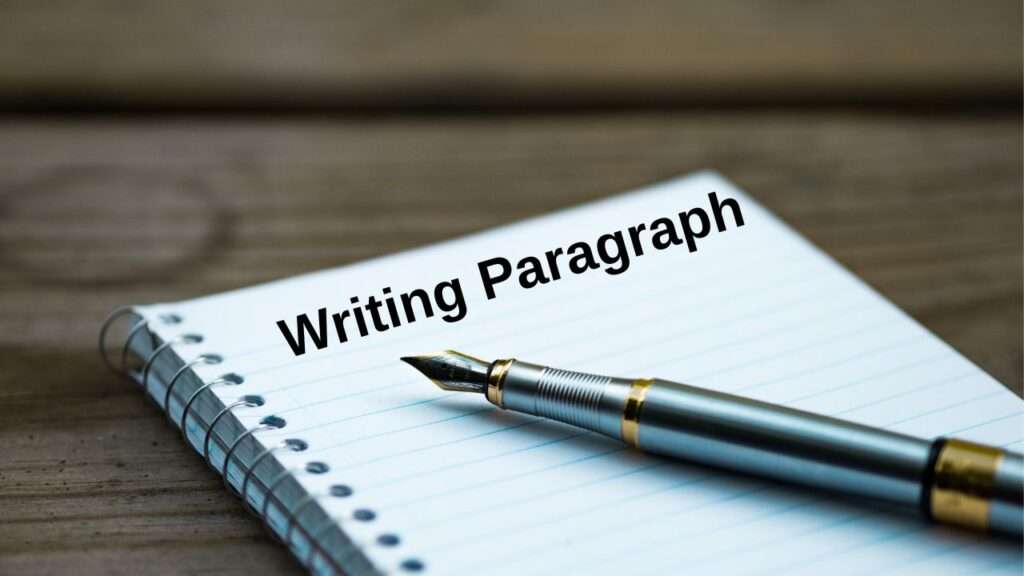Table of Contents
- 1 Paragraph Writing in English
- 1.1 Introduction
- 1.2 Format of an Ideal Paragraph
- 1.3 Conclusion
- 1.4 Type of Paragraph
- 1.5 List of Various Categorized Paragraphs for Kids and Students.
- 1.5.1 1. My Family
- 1.5.2 2. My School
- 1.5.3 3. My House
- 1.5.4 4. My Best Friend
- 1.5.5 5. My Village
- 1.5.6 6. A Picnic
- 1.5.7 7. A Scene at a Railway Station
- 1.5.8 8. A Visit to a Zoo
- 1.5.9 9. My Favourite Teacher
- 1.5.10 10. Our Headmaster
- 1.5.11 11. A Road Accident
- 1.5.12 12. Right to Education
- 1.5.13 13. Pollution
- 1.5.14 14. Beti Bachao Beti Padhao
- 1.5.15 15. Cleanliness
- 1.5.16 16. How Suji Laddus are Prepared
- 1.5.17 17. How kheer is prepared
Paragraph Writing in English
Introduction
Paragraph writing (in English) is an essential skill for anyone who wants to write in English effectively. It is the basic building block of written communication and allows the writer to express their thoughts and ideas in a clear and organized manner. A paragraph typically consists of several sentences that are focused on a single topic or idea.

Format of an Ideal Paragraph
Step – 1
The first step in writing a good paragraph is to identify the main idea that you want to convey. This main idea should be stated in the first sentence, known as the topic sentence. The rest of the sentences in the paragraph should then support and elaborate on this main idea. It is important to make sure that all of the sentences in the paragraph are related and connect to the topic sentence. This helps the reader to understand the main idea and follow the writer’s train of thought.
Step – 2
The length of a paragraph can vary, but it should be long enough to fully develop the main idea. A paragraph that is too short may not provide enough detail or context, while a paragraph that is too long may be difficult for the reader to follow. A good rule of thumb is to aim for four to six sentences in a paragraph.
Step – 3
When writing a paragraph, it is also important to pay attention to the language used. The words and phrases used should be clear and concise, and the writer should aim to avoid using technical terms or jargon that the reader may not understand. Additionally, the use of transition words and phrases can help to connect the sentences in a paragraph and make it easier for the reader to follow the writer’s train of thought.
Conclusion
In conclusion, paragraph writing is a critical skill for anyone who wants to write in English effectively. By following the guidelines of identifying the main idea, supporting it with relevant sentences, and paying attention to the language used, writers can craft clear and well-organized paragraphs that are easy for the reader to understand. With practice, anyone can improve their paragraph writing skills and become a more effective communicator.
Type of Paragraph
There are several types of paragraphs that serve different purposes in writing. Some of the most common types include:
1. Narrative Paragraph:
This type of paragraph tells a story or describes an event. It is often used in fiction writing, but can also be used in non-fiction writing to describe a personal experience or historical event.
2. Descriptive Paragraph:
This type of paragraph is used to describe a person, place, or thing in detail. The purpose is to create a vivid picture in the reader’s mind through the use of sensory details and descriptive language.
3. Expository Paragraph:
This type of paragraph is used to explain or inform the reader about a topic. It is often used in academic writing to present information in a clear and organized manner.
4. Persuasive Paragraph:
This type of paragraph is used to convince the reader to take a certain viewpoint or take a specific action. It is often used in argumentative writing, advertising, and political speeches.
5. Comparison and Contrast Paragraph:
This type of paragraph is used to compare and contrast two or more things. The purpose is to highlight the similarities and differences between the items being compared.
6. Cause and Effect Paragraph:
This type of paragraph is used to explain the relationship between a cause and an effect. The purpose is to show how one event or situation leads to another.
Each type of paragraph has its own specific structure and purpose, and writers should choose the type of paragraph that best fits the purpose of their writing. It is also important to note that a single piece of writing may contain several different types of paragraphs, each serving a specific purpose.